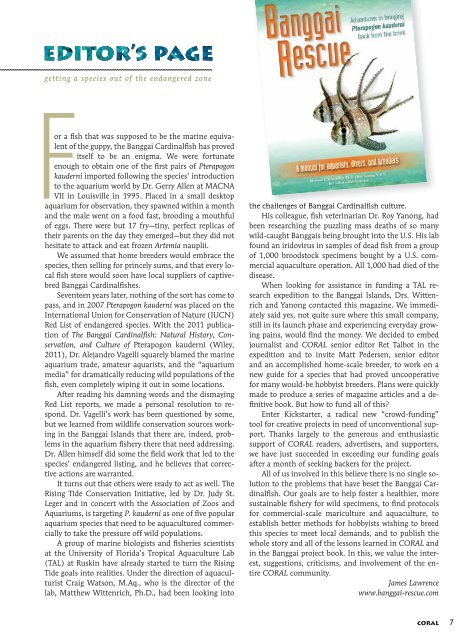You also want an ePaper? Increase the reach of your titles
YUMPU automatically turns print PDFs into web optimized ePapers that Google loves.
getting a species out of the endangered zone<br />
For a fish that was supposed to be the marine equivalent<br />
of the guppy, the Banggai Cardinalfish has proved<br />
itself to be an enigma. We were fortunate<br />
enough to obtain one of the first pairs of Pterapogon<br />
kauderni imported following the species’ introduction<br />
to the aquarium world by Dr. Gerry Allen at MACNA<br />
VII in Louisville in 1995. Placed in a small desktop<br />
aquarium for observation, they spawned within a month<br />
and the male went on a food fast, brooding a mouthful<br />
of eggs. There were but 17 fry—tiny, perfect replicas of<br />
their parents on the day they emerged—but they did not<br />
hesitate to attack and eat frozen Artemia nauplii.<br />
We assumed that home breeders would embrace the<br />
species, then selling for princely sums, and that every local<br />
fish store would soon have local suppliers of captivebred<br />
Banggai Cardinalfishes.<br />
Seventeen years later, nothing of the sort has come to<br />
pass, and in 2007 Pterapogon kauderni was placed on the<br />
International Union for Conservation of Nature (IUCN)<br />
Red List of endangered species. With the 2011 publication<br />
of The Banggai Cardinalfish: Natural History, Conservation,<br />
and Culture of Pterapogon kauderni (Wiley,<br />
2011), Dr. Alejandro Vagelli squarely blamed the marine<br />
aquarium trade, amateur aquarists, and the “aquarium<br />
media” for dramatically reducing wild populations of the<br />
fish, even completely wiping it out in some locations.<br />
After reading his damning words and the dismaying<br />
Red List reports, we made a personal resolution to respond.<br />
Dr. Vagelli’s work has been questioned by some,<br />
but we learned from wildlife conservation sources working<br />
in the Banggai Islands that there are, indeed, problems<br />
in the aquarium fishery there that need addressing.<br />
Dr. Allen himself did some the field work that led to the<br />
species’ endangered listing, and he believes that corrective<br />
actions are warranted.<br />
It turns out that others were ready to act as well. The<br />
Rising Tide Conservation Initiative, led by Dr. Judy St.<br />
Leger and in concert with the Association of Zoos and<br />
Aquariums, is targeting P. kauderni as one of five popular<br />
aquarium species that need to be aquacultured commercially<br />
to take the pressure off wild populations.<br />
A group of marine biologists and fisheries scientists<br />
at the University of Florida’s Tropical Aquaculture Lab<br />
(TAL) at Ruskin have already started to turn the Rising<br />
Tide goals into realities. Under the direction of aquaculturist<br />
Craig Watson, M.Aq., who is the director of the<br />
lab, Matthew Wittenrich, Ph.D., had been looking into<br />
the challenges of Banggai Cardinalfish culture.<br />
His colleague, fish veterinarian Dr. Roy Yanong, had<br />
been researching the puzzling mass deaths of so many<br />
wild-caught Banggais being brought into the U.S. His lab<br />
found an iridovirus in samples of dead fish from a group<br />
of 1,000 broodstock specimens bought by a U.S. commercial<br />
aquaculture operation. All 1,000 had died of the<br />
disease.<br />
When looking for assistance in funding a TAL research<br />
expedition to the Banggai Islands, Drs. Wittenrich<br />
and Yanong contacted this magazine. We immediately<br />
said yes, not quite sure where this small company,<br />
still in its launch phase and experiencing everyday growing<br />
pains, would find the money. We decided to embed<br />
journalist and CORAL senior editor Ret Talbot in the<br />
expedition and to invite Matt Pedersen, senior editor<br />
and an accomplished home-scale breeder, to work on a<br />
new guide for a species that had proved uncooperative<br />
for many would-be hobbyist breeders. Plans were quickly<br />
made to produce a series of magazine articles and a definitive<br />
book. But how to fund all of this?<br />
Enter Kickstarter, a radical new “crowd-funding”<br />
tool for creative projects in need of unconventional support.<br />
Thanks largely to the generous and enthusiastic<br />
support of CORAL readers, advertisers, and supporters,<br />
we have just succeeded in exceeding our funding goals<br />
after a month of seeking backers for the project.<br />
All of us involved in this believe there is no single solution<br />
to the problems that have beset the Banggai Cardinalfish.<br />
Our goals are to help foster a healthier, more<br />
sustainable fishery for wild specimens, to find protocols<br />
for commercial-scale mariculture and aquaculture, to<br />
establish better methods for hobbyists wishing to breed<br />
this species to meet local demands, and to publish the<br />
whole story and all of the lessons learned in CORAL and<br />
in the Banggai project book. In this, we value the interest,<br />
suggestions, criticisms, and involvement of the entire<br />
CORAL community.<br />
James Lawrence<br />
www.banggai-rescue.com<br />
CORAL<br />
7

















